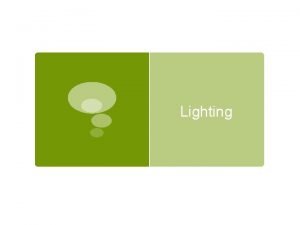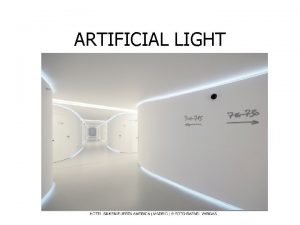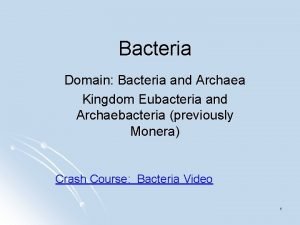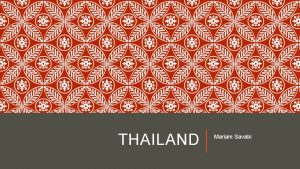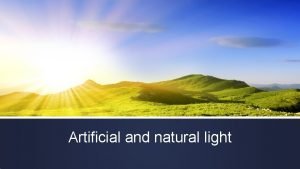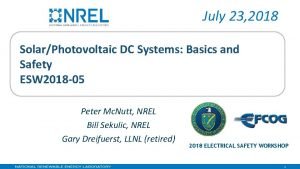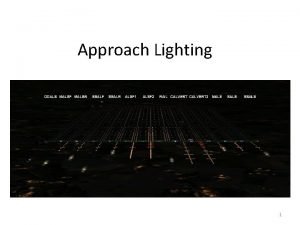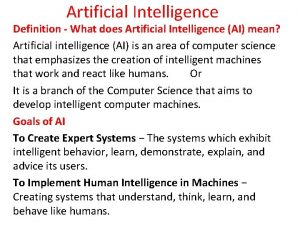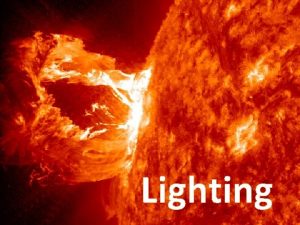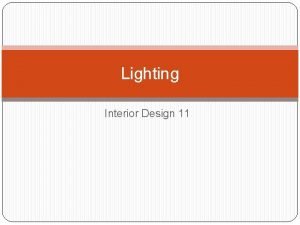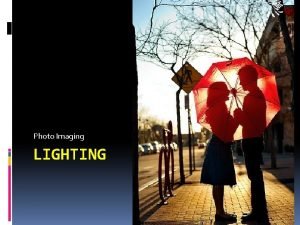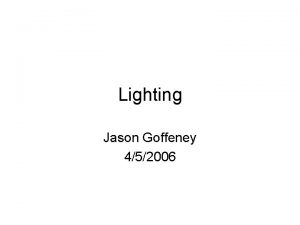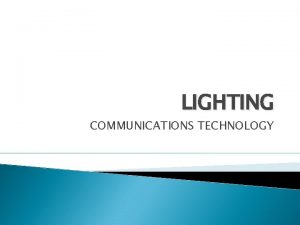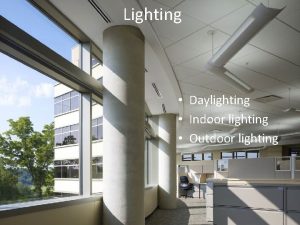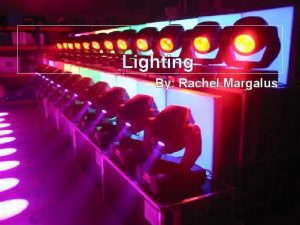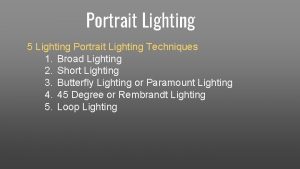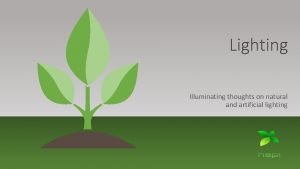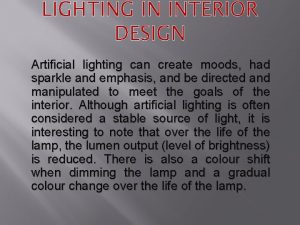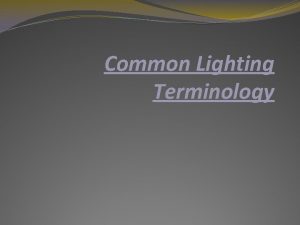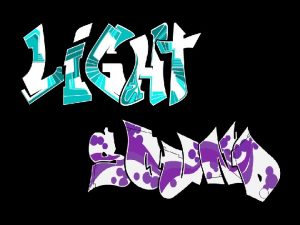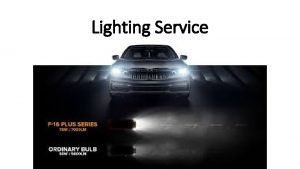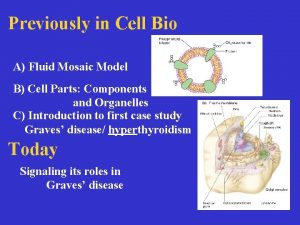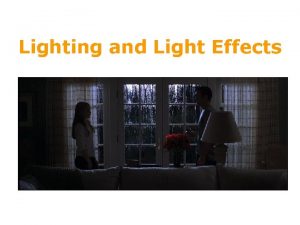Lighting Artificial Light Previously the 2 main types





































- Slides: 37

Lighting

Artificial Light Previously the 2 main types of artificial lighting was incandescent and fluorescent. New technology is replacing the old with other types of light sources

Types of Artificial Lighting Incandescent Light produced when an electric current passes through a fine tungsten filament inside a bulb Tungsten-Halogen Another form of Incandescent lighting. Halogen gas combines with tungsten molecules to activate a filament inside a quartz enclosure Fluorescent Light Produced in a glass tube by releasing electricity through a mercury vapor to make invisible ultraviolet rays

Types of Artificial Lighting Compact Fluorescent Lamps In CFLs, an electric current runs through a tube containing argon gas and a small amount of mercury vapor Fiber Optics Heatless light produced by passing an electric current through a cable containing very fine strands of glass Light-Emitting Diodes (LED) Composed of crystals on silicon chips and light is produced when a low electric current passes through them

Incandescent Light

Incandescent Light § The electricity heats the filament until it glows giving off light § Incandescent light bulbs range from 15 to 250 watts for the home. § The higher wattage gives more light § A lumen is a measurement of the amount of light a bulb produces § A higher lumen means the bulb emits more light § Incandescent bulbs produce very little light for the energy used § Not a very efficient source of light

Incandescent Light § Bulbs for the home use have a frost finish to § Reduce glare § Make shadows appear softer § Use clear bulbs only in fixtures that hid the bulbs § A three-way bulb can produce different amounts of light in a single bulb

The Energy Independence and Security Act § Established energy efficiency standards for many types of light bulbs § This includes the proposed phase-out of incandescent and other inefficient bulbs

Tungsten. Halogen (Quartz) Light

Tungsten-Halogen (Quartz) Light § Produces a whiter type of light § Bulbs last up to three times longer than regular incandescent bulbs § Tungsten is a metal compound that is released from the filament into the bulb § There is a small amount of halogen in the bulb that when it reacts to the tungsten, it creates light

Fluorescent Light

Fluorescent Light § A coating of fluorescent material on the inside of the glass tube converts these invisible ultraviolet rays into visible light § Produces about four times as much light as an incandescent bulb of the same wattage § Tubes are more expensive but last longer and are less expensive to use § Color varies by changing the fluorescent material coating in the tube § Cool-white intensifies blues and greens § Warm-white intensifies yellows, reds, and oranges § Often used in kitchens, bathrooms, and workshops

Compact Fluorescent Light

Compact Fluorescent Light § Replacing old incandescent bulbs § Uses a regular light bulb socket and comes in many sizes and shapes § Some CFLs have a cork-screw shape and newer models look like standard incandescent bulbs § Use about 75% less energy and operates for nearly 9, 000 hours § Broken CFLs can emit a small amount of dangerous mercury, so dispose properly

Fiber Optics

Fiber Optics § Permit transmissions over longer distances and high bandwidths § Dramatic Effect in interior spaces

Light-Emitting Diodes (LED)

Light-Emitting Diodes (LED) § Composed of crystals on silicon chips the size of a grain of salt § Produce light when a low electric current passes through them § Can last 10, 000 hours or more § More expensive but, § Lasts longer § Energy efficient § More durable § Gives off less heat

Properties of Light

Properties of Light § Can use to achieve several effects in a home § Objects and surfaces absorb or reflect light § Light can shine directly on a certain spot or lighten a whole room

Reflected Light § Light, color, and texture are closely related § Without light, there is no color § Colors reflect and absorb various amounts of light § Rough textures look dark because tiny shadows form where the light does not reach § Reflected light is light that bounces off surfaces § Light comes from the surface and the source § Surfaces that reflect light include § Light colors, background treatments, smooth/shiny surfaces § Avoid lighting placement that creates glare

Absorbed Light § Drawn in by a surface § Rough textures and dark colors absorb most available light rays § If light is absorbed, it cannot be reflected § A room with many dark surfaces may require additional light for certain activities

Diffused Light § Light that scatters over a large area § No glare and creates a soft appearance § Devices that diffuse light, or diffusers, spread light evenly § A lamp shad covering a light fixture serves as a diffuser

Light Temperature § Color temperature is the color of light as rated in kelvin (K) § A temperature scale that impacts how items appear in light § Light from these sources is divided into the following general tones: § Orange (incandescent) 27003000*K § White (halogen) 3000 -3600*K § Blue (florescent) 3000*K for warm, 4000* for cool § Keep in mind how the light affects the surfaces when selecting lights

Color Rendering Index (CRI) § Indicates how well light from a source brings out the true color § The CRI scale is from 1 -100 with 100 equaling the color rendering of daylight § The closer the CRI of a light source is to 100, the more accurately the light reproduces color

Functions of Lighting

Functions of Lighting § Illuminates the environment so that people can comfortably see when performing certain tasks § Especially those that pose a safety hazard § Lighting also brings attention to § Beautiful objects § Attractive architectural features

Lighting for Visual Comfort § Two types of lighting create visual comfort § General (Ambient) § Task § The type and amount of light needed varies from room to room

Ambient Lighting § General lighting provides uniform light throughout a room § Lighting that shines directly toward an object is direct lighting and § Provides the most possible light to a specific area § Creates a sharp contrast between light and dark areas § Should be used with other room lighting § Indirect lighting is directed toward a surface, such as a ceiling or wall that reflects light into a room § Indirect Lighting § May provide soft light for a large area § Is not enough light for detailed work

Task Lighting § Used in areas where specific activities require more light § The right amount of light helps prevent eyestrain § The finer the detail or the faster the action taking place, the more light is needed § Task lighting can serve as general lighting for another part of a room § Combine general and task light to give adequate light without sharp contrast § Use higher levels of task lighting to assure good vision when performing tasks § Writing § Carving Wood § Sewing § Reading

Measuring Light § Wattage is the amount of electricity a light bulb uses § A lumen is a measurement of the amount of light a bulb produces § One lumen is the amount of light produced by a source equaling the intensity of one standard candle § Foot-candle is a measurement of how much light reaches an object or surface § One-foot candle is the amount of light a candle gives to an object one foot away § One foot-candle equals one lumen per square foot § You can measure the amount of light reaching a surface with a light meter

Lighting for Safety § Prevent accidents and fires § Light your way from room to § § § room Switch lights on and off from each doorway Turn on stairway lights when using stairs Light entrances Control garage and carport lighting form inside or outside the home Control outside lighting form inside the home Wiring must meet safety standards § The National Electrical Code is a standard with which all wiring should comply § Underwriters Laboratories (UL) is a safety-testing organization § Always read and follow the instructions the use and care of the lights

Lighting for Beauty § Some lighting is decorative, which adds beauty to a space § Soft light can create a quiet, restful mood § Sharp light can highlight the focal point in a room § Accent lighting is a form of lighting that serves as a highlight § Use a decorative lighting outside the home § Yard lights next to the street § Lights near entrances § Lighting patios for night use

Structural and Nonstructural Lighting The two ways to deliver light

Structural Lighting § Permanently built into a home § Keep structural light fixtures in harmony with other aspects of the room’s design § Consider the following points about structural lighting § Diffused light gives more visual comfort § Fixtures that can change position to allow for usage in more than one way § Provide different light levels allow for more flexibility in the home

Structural Lighting § Types of structural lighting fixtures include: § Valance lighting § Bracket lighting § Cornice lighting § Cove lighting § Recessed down § Soffit lighting § Wall washers § Strip lighting § Track lighting

Nonstructural Lighting § Nonstructural lighting is lighting that is not a structural part of the house § Move, change, and replace these lights more easily than any other lighting § Lamps are the most common type of nonstructural lighting § When choosing lamps, consider § Sturdy or heavy base, prevents tipping § Prevents glare § Harmonizing colors and textures § Light-colored, translucent lampshades
 Types of artificial light
Types of artificial light Artificial light types
Artificial light types Light light light chapter 23
Light light light chapter 23 Into the light chapter 22
Into the light chapter 22 Chapter 22
Chapter 22 Archaea facts
Archaea facts Mariam savabi
Mariam savabi Rsro ncaa
Rsro ncaa Csun mse 227
Csun mse 227 Artificial and natural light
Artificial and natural light Source of artificial light
Source of artificial light Red side row bars
Red side row bars Types of knowledge in artificial intelligence
Types of knowledge in artificial intelligence Types of artificial intelligencel
Types of artificial intelligencel Reactive machines definition
Reactive machines definition Artificial probing chapter 2
Artificial probing chapter 2 Ways of expressing future time
Ways of expressing future time Types of main idea
Types of main idea Void main int main
Void main int main Put out the light othello
Put out the light othello Membrane-bound organelles
Membrane-bound organelles The bouncing off of light.
The bouncing off of light. Materials can block light
Materials can block light Hát kết hợp bộ gõ cơ thể
Hát kết hợp bộ gõ cơ thể Slidetodoc
Slidetodoc Bổ thể
Bổ thể Tỉ lệ cơ thể trẻ em
Tỉ lệ cơ thể trẻ em Chó sói
Chó sói Chụp tư thế worms-breton
Chụp tư thế worms-breton Alleluia hat len nguoi oi
Alleluia hat len nguoi oi Môn thể thao bắt đầu bằng chữ đua
Môn thể thao bắt đầu bằng chữ đua Thế nào là hệ số cao nhất
Thế nào là hệ số cao nhất Các châu lục và đại dương trên thế giới
Các châu lục và đại dương trên thế giới Công thức tính thế năng
Công thức tính thế năng Trời xanh đây là của chúng ta thể thơ
Trời xanh đây là của chúng ta thể thơ Cách giải mật thư tọa độ
Cách giải mật thư tọa độ Làm thế nào để 102-1=99
Làm thế nào để 102-1=99 Phản ứng thế ankan
Phản ứng thế ankan
